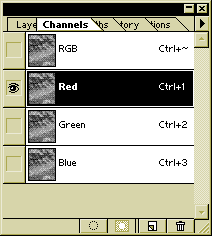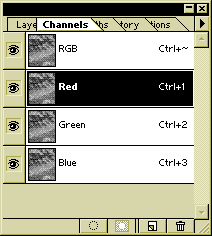a) Verify that the background is white. To do this check under the color palette, which is on the right side. There are two overlapping boxes, one is white, the other black. Click the white box. You should verify that the colors to the right of the box are light. Now click the black box and verify that it darkens the colors significantly. Finally, click the white box again. You want the background to be light. Otherwise the images will come out reversed.

Clicking in the box with the word "Red" selects the red channel.

- Clicking on the small box to the left of the "RGB"
box makes an eye appear to the left of every channel. This does not
change the selected channel (in this case, red), and will allow you to
view the composited RGB image.